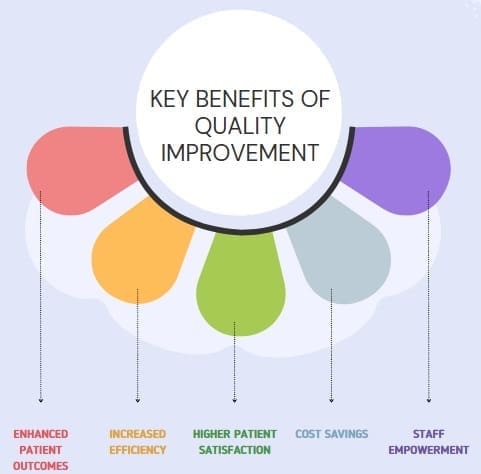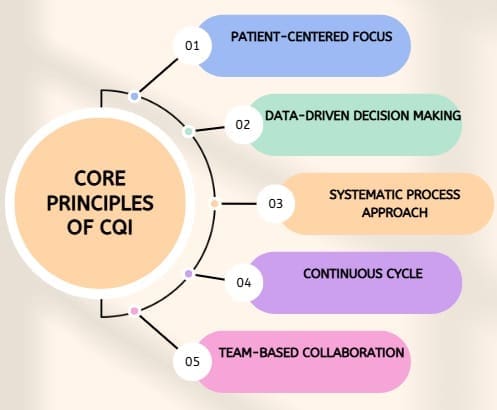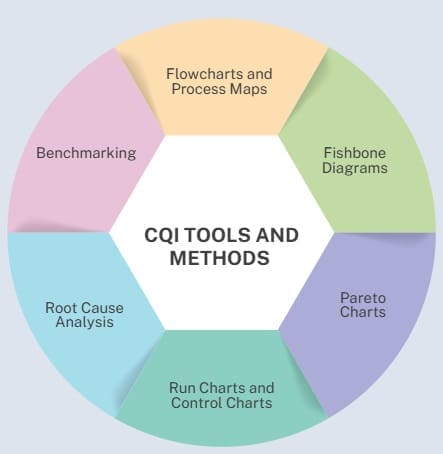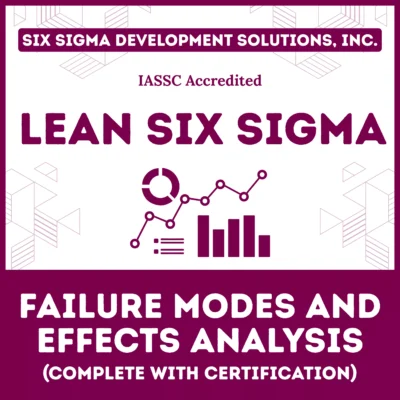Continuous quality improvement in healthcare represents a structured organizational process involving people in planning and executing ongoing improvements to provide quality health care that meets or exceeds expectations. More simply, CQI encourages all healthcare team members to continuously ask fundamental questions: “How are we doing?” and “Can we do it better?”
Unlike traditional quality assurance approaches that react to problems after they occur, CQI takes a proactive stance. It operates on the philosophy that anything can be improved and rejects the notion that the “status quo” is good enough. This mindset shift fundamentally changes how healthcare organizations approach excellence.
The CQI meaning extends beyond simple problem-solving. It represents a cultural transformation where every team member—from physicians and nurses to administrative staff and support personnel—participates in identifying opportunities for improvement. This collaborative approach ensures that changes reflect frontline realities and gain widespread support during implementation.
Table of contents
What is Continuous Quality Improvement?
Continuous Quality Improvement, often abbreviated as CQI, is a structured, ongoing process designed to enhance services, processes, and outcomes. At its core, CQI is about identifying inefficiencies, implementing changes, and consistently evaluating results to ensure sustained progress. Unlike one-off fixes, CQI is a mindset—a commitment to never settling for “good enough.”
In healthcare, CQI focuses on improving patient safety, care quality, and operational efficiency. It’s not just about fixing problems but proactively seeking ways to do better. Think of it as a cycle: plan, do, check, act (PDCA), repeated endlessly to refine systems. This iterative approach ensures healthcare providers deliver exceptional care while adapting to evolving needs.
CQI Meaning and Origins
The term “CQI” stems from quality management principles pioneered by thinkers like W. Edwards Deming and Joseph Juran. Originally developed for manufacturing, CQI found a natural home in healthcare, where precision and consistency save lives. Today, CQI in healthcare is synonymous with systematic efforts to reduce errors, enhance patient satisfaction, and optimize resources.
Also Read: Kaikaku – Japanese Improvement Model
Why is Continuous Quality Improvement Important in Healthcare?
Healthcare is complex, with countless moving parts—doctors, nurses, administrators, and patients all interacting within intricate systems. Errors, inefficiencies, or outdated practices can lead to suboptimal care, higher costs, or even harm. CQI addresses these challenges head-on by fostering a culture of accountability and innovation.
Key Benefits of Quality Improvement in Healthcare

- Enhanced Patient Outcomes: CQI reduces medical errors, shortens hospital stays, and improves recovery rates.
- Increased Efficiency: Streamlined processes save time and resources, allowing staff to focus on patient care.
- Higher Patient Satisfaction: Better care experiences lead to happier patients and stronger trust in providers.
- Cost Savings: By reducing waste and errors, CQI lowers operational costs for healthcare organizations.
- Staff Empowerment: Nurses and staff engaged in CQI initiatives feel valued, boosting morale and collaboration.
For example, a hospital implementing CQI might reduce medication errors by standardizing prescription protocols, directly impacting patient safety and trust.
Public, Onsite, Virtual, and Online Six Sigma Certification Training!
- We are accredited by the IASSC.
- Live Public Training at 52 Sites.
- Live Virtual Training.
- Onsite Training (at your organization).
- Interactive Online (self-paced) training,
Core Principles of CQI

What does CQI stand for in the healthcare context? Beyond the acronym, CQI embodies several foundational principles that guide improvement efforts:
Patient-Centered Focus: Quality improvement initiatives prioritize patient needs, safety, and satisfaction above all else. Every improvement project should ultimately enhance patient experiences and outcomes.
Data-Driven Decision Making: Rather than relying on assumptions or anecdotal evidence, CQI requires objective data collection and analysis. Measurable indicators track progress and validate improvement strategies.
Systematic Process Approach: CQI recognizes that most problems stem from flawed processes rather than individual failures. By improving systems, organizations achieve sustainable results that persist regardless of specific personnel.
Continuous Cycle: Quality improvement never reaches a final destination. Instead, it represents an ongoing journey where organizations constantly seek better methods, refine existing processes, and adapt to changing circumstances.
Team-Based Collaboration: Cross-functional teams bring diverse perspectives to problem-solving, ensuring comprehensive solutions that address root causes rather than symptoms.
These principles create a framework for organizational learning and adaptation, enabling healthcare systems to evolve continuously in response to emerging challenges and opportunities.
Also Read: Quality Improvement Teams
Continuous Quality Improvement Process
The CQI process is designed to be systematic yet flexible, adapting to the unique needs of each organization. Most CQI frameworks rely on the PDCA cycle:
- Plan: Identify a problem, gather data, and develop a solution.
- Do: Implement the solution on a small scale to test its effectiveness.
- Check: Analyze results to see if the solution worked as intended.
- Act: Standardize successful changes or refine the approach for another cycle.
This cycle ensures continuous improvement in quality management, with each iteration building on the last. Tools like flowcharts, cause-and-effect diagrams, and Pareto charts often support this process, helping teams visualize problems and solutions.
Examples
To truly grasp CQI’s impact, let’s explore some examples of continuous quality improvement in healthcare.
Example 1: Reducing Hospital Readmissions
A community hospital noticed high readmission rates for heart failure patients. Using CQI, the team conducted a root cause analysis and found that patients lacked clear discharge instructions. They implemented a new protocol: nurses provided detailed, patient-friendly discharge plans and followed up via phone calls. After six months, readmissions dropped by 20%, and patient satisfaction scores soared.
Example 2: Streamlining Emergency Room Wait Times
An urban hospital’s emergency department faced long wait times, frustrating patients. Using Lean methodology, the team mapped the patient journey and identified bottlenecks, such as delays in triage. They introduced a fast-track system for non-critical cases, cutting average wait times by 30%. This not only improved patient experience but also reduced staff burnout.
Example 3: Enhancing Nursing Quality Improvement
In a nursing-led CQI project, a hospital aimed to reduce pressure ulcers in bedridden patients. Nurses used a PDSA cycle to test new repositioning schedules and specialized mattresses. Data showed a 15% decrease in ulcer incidents within three months, proving the power of nursing quality improvement initiatives.
These examples highlight how CQI transforms healthcare by addressing specific, measurable problems with targeted solutions.
Quality Improvement Initiatives in Healthcare
Healthcare organizations launch quality improvement initiatives to tackle systemic issues. These initiatives often align with national standards, such as those set by the Joint Commission or the Institute for Healthcare Improvement (IHI). Common focus areas include:
- Patient Safety: Reducing falls, infections, or medication errors.
- Care Coordination: Improving communication between departments to ensure seamless care.
- Health Equity: Addressing disparities in care access and outcomes.
- Technology Integration: Using electronic health records (EHRs) to enhance data-driven decisions.
For instance, the Utah Department of Health and Human Services (DHHS) has embraced CQI to improve public health outcomes, integrating quality improvement frameworks into their organizational chart to ensure accountability at every level.
Challenges in Implementing CQI
While CQI is powerful, it’s not without hurdles. Common challenges include:
- Resistance to Change: Staff may be hesitant to adopt new processes.
- Resource Constraints: Limited budgets or staffing can hinder initiatives.
- Data Overload: Collecting and analyzing data can overwhelm teams without proper tools.
- Sustaining Momentum: Maintaining long-term commitment to CQI requires strong leadership.
Overcoming these challenges requires clear communication, training, and a culture that celebrates small wins. Leadership buy-in is crucial to drive CQI forward.
CQI Tools and Methods for Healthcare Excellence

Quality improvement practitioners employ various tools that facilitate analysis, planning, and implementation. These CQI tools provide structure to improvement efforts:
Flowcharts and Process Maps: Visual representations showing how processes currently function, identifying decision points, delays, and redundancies.
Fishbone Diagrams: Also called cause-and-effect diagrams, these tools help teams systematically explore all potential causes contributing to problems.
Pareto Charts: These graphs identify which issues cause the most impact, following the principle that 80% of problems often stem from 20% of causes.
Run Charts and Control Charts: These track performance over time, revealing trends, patterns, and whether changes truly improve outcomes or simply reflect normal variation.
Root Cause Analysis: Structured investigations that dig beneath surface symptoms to identify underlying system failures enabling errors.
Benchmarking: Comparing performance against peer organizations or best practices to identify gaps and improvement opportunities.
Effective teams select tools appropriate to their specific challenges rather than applying every technique to every situation. The goal is insight leading to action, not analysis for its own sake.
How to Develop a Continuous Quality Improvement Plan?
Creating a CQI plan involves strategic steps to ensure success:
- Assess Current Performance: Use data to identify areas for improvement, like high infection rates.
- Set Clear Goals: Define specific, measurable objectives, such as reducing infections by 10%.
- Engage Stakeholders: Involve nurses, doctors, and patients to ensure buy-in.
- Choose CQI Tools: Select methods like Six Sigma or PDSA that fit the problem.
- Monitor Progress: Regularly track metrics and adjust strategies as needed.
- Celebrate Success: Recognize achievements to maintain motivation.
A well-crafted healthcare quality improvement plan aligns with organizational goals and prioritizes patient-centered care.
Continuous Improvement in Quality Management
CQI isn’t just for healthcare—it’s a cornerstone of quality management across industries. By fostering a culture of continuous improvement, organizations can stay competitive and responsive to change. In healthcare, this means adapting to new technologies, regulations, and patient expectations while maintaining high standards.
Final Words
Continuous Quality Improvement is more than a buzzword—it’s a lifeline for healthcare organizations striving to deliver exceptional care. By embracing CQI, hospitals, clinics, and nursing teams can enhance patient outcomes, boost efficiency, and foster a culture of excellence. From reducing readmissions to streamlining emergency care, CQI’s impact is undeniable. As healthcare evolves, CQI remains a steadfast ally, ensuring that quality never takes a backseat.
FAQs on CQI
What does CQI stand for in healthcare?
CQI stands for Continuous Quality Improvement, a systematic approach to enhancing processes, patient care, and outcomes in healthcare settings.
What is the continuous quality improvement process designed to do?
The CQI process is designed to identify inefficiencies, implement targeted solutions, and continuously evaluate results to ensure sustained improvements in quality and performance.
Why is quality improvement important in healthcare?
Quality improvement is critical in healthcare to enhance patient safety, reduce errors, improve efficiency, and ensure better patient experiences and outcomes.
What are some examples of continuous quality improvement in healthcare?
Examples include reducing hospital readmissions through better discharge planning, streamlining emergency room wait times, and decreasing pressure ulcers with new nursing protocols.
Which is a benefit of quality improvement programs in healthcare?
A key benefit is improved patient outcomes, such as fewer medical errors, shorter hospital stays, and higher patient satisfaction.



















